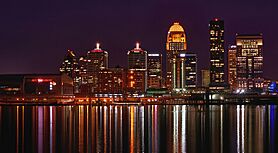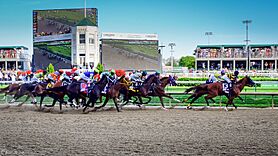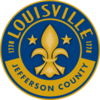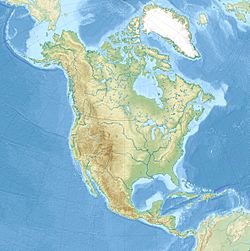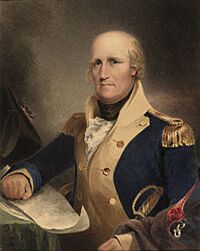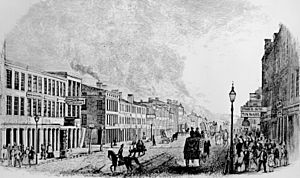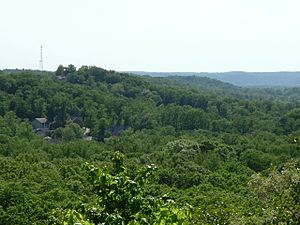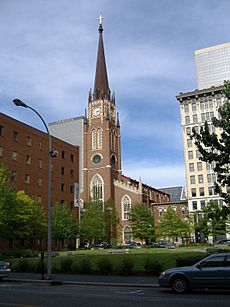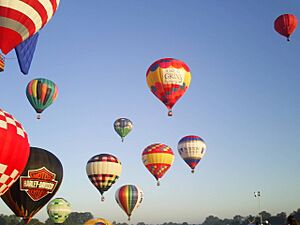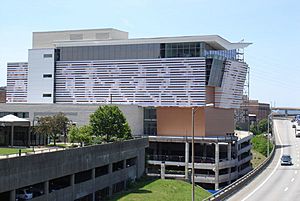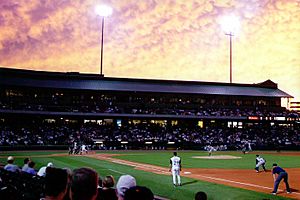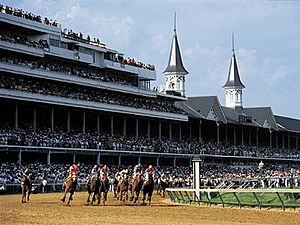Louisville, Kentucky facts for kids
Quick facts for kids
Louisville
|
|||
|---|---|---|---|
|
Consolidated city-county
|
|||
| Louisville/Jefferson County Metro Government |
|||
|
Downtown Louisville skyline
Thunder Over Louisville
|
|||
|
|||
| Nicknames:
Derby City, River City, (The) Gateway to the South, Falls City, The 'Ville
|
|||
| Country | United States | ||
| State | Kentucky | ||
| County | Jefferson | ||
| Established | 1778 | ||
| Incorporated | 1828 | ||
| Founded by | George Rogers Clark | ||
| Named for | Louis XVI | ||
| Government | |||
| • Type | Mayor–council | ||
| Area | |||
| • Consolidated city-county | 341.44 sq mi (884.32 km2) | ||
| • Land | 324.94 sq mi (841.59 km2) | ||
| • Water | 16.50 sq mi (42.73 km2) | ||
| Elevation | 466 ft (142 m) | ||
| Population
(2020)
|
|||
| • Consolidated city-county | 633,045 | ||
| • Estimate
(2022)
|
624,444 | ||
| • Rank | 76th in North America 27th in the United States 1st in Kentucky |
||
| • Density | 1,854.045/sq mi (715.855/km2) | ||
| • Urban | 1,025,000 (US: 46th) | ||
| • Urban density | 2,430.8/sq mi (938.5/km2) | ||
| • Metro | 1,365,557 (US: 43rd) | ||
| Demonym(s) | Louisvillian | ||
| GDP | |||
| • MSA | $90.836 billion (2022) | ||
| Time zone | UTC-5 (EST) | ||
| • Summer (DST) | UTC-4 (EDT) | ||
| ZIP code prefixes |
40201-40225, 40228-40229, 40231-40233, 40241-40243, 40245, 40250-40253, 40255-40259, 40261, 40266, 40268-40270, 40272, 40280-40283, 40285, 40287, 40289-40299
|
||
| Area code | 502 | ||
| FIPS code | 21-48000 | ||
| FIPS code | 21-48006 | ||
| GNIS feature ID | 2404963 | ||
Louisville is the largest city in Kentucky. It is also the 27th most populated city in the United States. Louisville is located on the Ohio River, right on the border with Indiana.
The city was founded in 1778 by George Rogers Clark. It was named after King Louis XVI of France. Louisville grew because of its location near the Falls of the Ohio. This area was a natural stopping point for river boats.
Today, Louisville is famous for many things. It is the hometown of boxing legend Muhammad Ali. It is also known for the Kentucky Derby horse race and Kentucky Fried Chicken. Other famous things include Louisville Slugger baseball bats and the University of Louisville. The city is also home to UPS's huge worldwide shipping hub at Louisville Muhammad Ali International Airport.
Since 2003, Louisville's city limits are the same as Jefferson County. This happened after the city and county governments joined together. The official name for this combined government is the Louisville/Jefferson County Metro Government. Even with this change, people still use "Jefferson County" to talk about the larger area.
Contents
- Understanding Louisville's Name: Pronunciation Guide
- Louisville's Past: A Journey Through History
- Exploring Louisville: Geography and Cityscape
- People of Louisville: Demographics
- Louisville's Work: Economy and Jobs
- Louisville's Fun: Arts and Culture
- Louisville's Games: Sports Scene
- Outdoor Fun: Parks and Recreation
- Learning in Louisville: Education
- News and Entertainment: Media
- Getting Around: Transportation
- Famous People from Louisville
- Louisville's Firsts: Important Achievements
- Louisville's Friends: Sister Cities
- Images for kids
- See also
Understanding Louisville's Name: Pronunciation Guide
People often say the name Louisville in different ways. Here are the three most common pronunciations:
All three ways are generally fine to use. The Louisville Visitor Center says that only ![]() i/ˈluːɪsvɪl/ loo-ISS-vil is not correct for this city. That pronunciation is for a smaller city in Colorado.
i/ˈluːɪsvɪl/ loo-ISS-vil is not correct for this city. That pronunciation is for a smaller city in Colorado.
Most people who live in Louisville say loo-Ə-vəl. Some even think it is the only right way. The loo-EE-vil pronunciation is less common among locals. However, people not from the area often use it. The LUUV-əl pronunciation is also acceptable but not as common.
Louisville's Past: A Journey Through History
Louisville's history goes back hundreds of years. Its location near the Falls of the Ohio River has always been very important.
Early Days: How Louisville Began
The Falls of the Ohio made it hard for boats to travel. So, settlements grew at this stopping point. The first European settlement near Louisville was on Corn Island in 1778. It was started by Colonel George Rogers Clark. He is known as the founder of Louisville. Many places in the city are named after him.
In 1780, the Virginia General Assembly officially approved Louisville as a town. The city was named to honor King Louis XVI of France. His soldiers were helping Americans in the American Revolutionary War. Early residents lived in forts for safety. By the late 1780s, they moved out of the forts. In 1803, explorers Meriwether Lewis and William Clark started their famous Lewis and Clark Expedition nearby.
The 1800s: Growth and Challenges
Louisville grew quickly because river boats had to unload their goods before the falls. By 1828, the city had 7,000 people and became an official city.
Louisville was a major shipping port. Many African Americans were forced to work in various trades. The city was often a place where people seeking freedom could escape to the north. Indiana was a state where slavery was not allowed.
The city faced challenges in the 1850s. On August 6, 1855, a sad event called "Bloody Monday" happened. Mobs attacked neighborhoods, causing deaths and damage. Later, during the American Civil War, Louisville was a strong base for the Union Army. This helped keep Kentucky on the Union side. The city itself was not attacked during the war. After the war, former Confederate soldiers gained political power in the city.
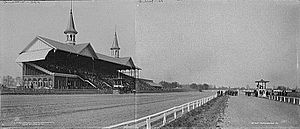
The first Kentucky Derby was held on May 17, 1875. It took place at the Louisville Jockey Club track, now called Churchill Downs. Horse racing was already very popular in Kentucky. Ten thousand people watched the first Derby. A horse named Aristides won the race.
On March 27, 1890, a powerful tornado hit Louisville. It caused a lot of damage downtown. Between 74 and 120 people lost their lives. The damage cost the city $2.5 million.
The 1900s and 2000s: Modern Louisville
After the Civil War, many freed African Americans settled in a Louisville neighborhood called Little Africa. It was known as "the gateway to the South."
In 1914, Louisville passed a law about where people of different races could live. The NAACP (National Association for the Advancement of Colored People) challenged this law. In 1917, the U.S. Supreme Court ruled that the law was unfair. This decision helped fight against segregation.
During World War I, Louisville was home to Camp Zachary Taylor. This was one of the largest training camps in the country. Over 150,000 soldiers trained there, including writer F. Scott Fitzgerald.
In 1937, a huge flood, called the "Great Flood of 1937," hit Louisville. The Ohio River rose very high. About 60-70 percent of the city was underwater. Many people had to leave their homes. This flood led to the building of flood walls to protect the city. After the flood, many people moved to higher areas in the eastern part of the city.
During World War II, Louisville was important for making war supplies. A factory here built cargo planes. After the war, it became a factory for farm equipment.
Louisville tried to be a fair city for all races. However, some unfair practices continued by custom, not by law. This was sometimes called "polite racism."
Like many older American cities, Louisville saw people and businesses move to the suburbs in the 1960s and 1970s. This caused some older areas to decline.
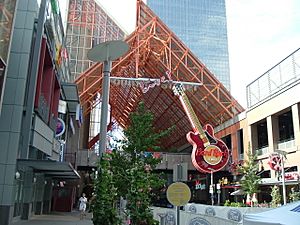
In 1974, another strong tornado hit Louisville. It destroyed many homes and caused two deaths.
Since the 1980s, many city neighborhoods have been improved. Areas like Bardstown Road and Old Louisville became popular again. Downtown Louisville has also seen a lot of new growth. New sports stadiums like KFC Yum! Center and Lynn Family Stadium were built. The waterfront was turned into Louisville Waterfront Park. Old buildings were made new, like Fourth Street Live!, an entertainment complex.
In 2020, there were protests in Louisville. These protests were part of a larger movement for fairness and equality.
Exploring Louisville: Geography and Cityscape
Louisville and Jefferson County cover about 397 square miles (1,029 square kilometers). Most of this area is land.
Louisville is in north-central Kentucky, along the Ohio River. It is a city in the Upper South. This means it has influences from both Southern and Midwestern cultures.
The city's location on the Ohio River helped it grow into a major shipping port. Much of Louisville is on a wide, flat floodplain. Hills surround this area. Many creeks were moved or put into canals in the 1840s. This helped prevent floods and diseases.
Areas east of I-65 are generally higher and have rolling hills. The southern parts of Jefferson County are in the scenic Knobs region. This area is home to Jefferson Memorial Forest.
The Louisville area is close to other cities. These include Frankfort, Kentucky (the state capital), Cincinnati, Ohio, and Lexington, Kentucky.
City Views: Louisville's Unique Look
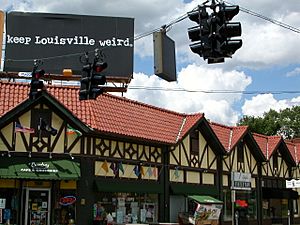
Downtown Louisville is just south of the Ohio River. Major roads spread out from downtown in all directions. The Louisville Muhammad Ali International Airport is about 6.75 miles (10.86 km) south of downtown. Most residential areas are to the southwest, south, and east of downtown.
In 2010, the KFC Yum! Center was finished. This is a large arena with 22,000 seats. Many of Kentucky's tallest buildings are in downtown Louisville.
Louisville's buildings mix old and new styles. The Old Louisville neighborhood has the largest collection of Victorian homes in the U.S. Downtown's West Main Street has many buildings with cast iron fronts. This is the largest collection outside of New York's SoHo neighborhood.
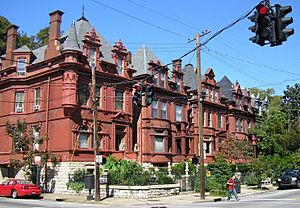
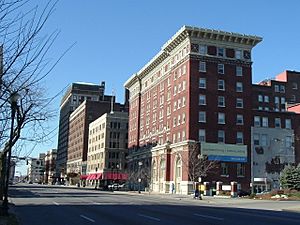
Since the mid-1900s, Louisville has been seen as having three main parts: the West End, the South End, and the East End. The West End is often thought of as the African American part of town. The South End is known for white, working-class families. The East End is seen as middle and upper class.
Immigrants from Southeast Asia often live in the South End. People from Eastern Europe tend to settle in the East End.
{{wide image|Louisville Panorama.jpg|880px|alt=Louisville panorama from Jeffersonville, Indiana, with Second Street Bridge in foreground|A panorama of Louisville from Jeffersonville, Indiana. The George Rogers Clark Memorial Bridge is in the front.]]
Louisville's Weather: Climate Overview
Louisville has a humid subtropical climate. This means it has hot, humid summers and mild winters. Spring usually starts in mid-to-late March. Summer lasts from mid-to-late May to late September. Fall is in October and November.
Sometimes, the weather can be extreme in spring and fall. Tornadoes can happen in the region. Winter brings a mix of rain, sleet, and snow. Heavy snow and ice can occur.
Louisville averages 38 days a year with temperatures at or above 90°F (32°C). The average yearly temperature is 58.2°F (14.6°C). The city gets about 12.7 inches (32.3 cm) of snow and 44.9 inches (114 cm) of rain each year.
July is usually the hottest month. January is the coldest. The highest temperature ever recorded was 107°F (42°C) in 1936. The lowest was -22°F (-30°C) in 1994. Temperatures in downtown areas can be a bit warmer than in the suburbs.
| Climate data for Louisville International Airport, Kentucky (1981–2010 normals, extremes 1872–present ) | |||||||||||||
|---|---|---|---|---|---|---|---|---|---|---|---|---|---|
| Month | Jan | Feb | Mar | Apr | May | Jun | Jul | Aug | Sep | Oct | Nov | Dec | Year |
| Record high °F (°C) | 77 (25) |
78 (26) |
88 (31) |
91 (33) |
98 (37) |
105 (41) |
107 (42) |
105 (41) |
104 (40) |
93 (34) |
85 (29) |
76 (24) |
107 (42) |
| Mean maximum °F (°C) | 64.7 (18.2) |
69.4 (20.8) |
78.5 (25.8) |
84.2 (29.0) |
87.8 (31.0) |
92.9 (33.8) |
95.5 (35.3) |
95.7 (35.4) |
91.8 (33.2) |
84.3 (29.1) |
75.3 (24.1) |
65.3 (18.5) |
97.0 (36.1) |
| Mean daily maximum °F (°C) | 43.0 (6.1) |
47.8 (8.8) |
57.9 (14.4) |
68.8 (20.4) |
77.1 (25.1) |
85.3 (29.6) |
88.7 (31.5) |
88.3 (31.3) |
81.5 (27.5) |
70.1 (21.2) |
57.9 (14.4) |
45.8 (7.7) |
67.8 (19.9) |
| Mean daily minimum °F (°C) | 26.8 (−2.9) |
29.9 (−1.2) |
37.8 (3.2) |
47.3 (8.5) |
57.0 (13.9) |
66.0 (18.9) |
69.9 (21.1) |
68.5 (20.3) |
60.5 (15.8) |
48.9 (9.4) |
39.5 (4.2) |
30.0 (−1.1) |
48.6 (9.2) |
| Mean minimum °F (°C) | 4.9 (−15.1) |
10.2 (−12.1) |
20.1 (−6.6) |
30.4 (−0.9) |
41.0 (5.0) |
52.1 (11.2) |
58.7 (14.8) |
57.2 (14.0) |
44.7 (7.1) |
32.8 (0.4) |
23.0 (−5.0) |
9.2 (−12.7) |
0.2 (−17.7) |
| Record low °F (°C) | −22 (−30) |
−19 (−28) |
−1 (−18) |
21 (−6) |
31 (−1) |
42 (6) |
49 (9) |
45 (7) |
33 (1) |
23 (−5) |
−1 (−18) |
−15 (−26) |
−22 (−30) |
| Average precipitation inches (mm) | 3.24 (82) |
3.18 (81) |
4.17 (106) |
4.01 (102) |
5.27 (134) |
3.79 (96) |
4.23 (107) |
3.33 (85) |
3.05 (77) |
3.22 (82) |
3.59 (91) |
3.83 (97) |
44.91 (1,141) |
| Average snowfall inches (cm) | 3.7 (9.4) |
4.5 (11) |
1.4 (3.6) |
0.1 (0.25) |
0 (0) |
0 (0) |
0 (0) |
0 (0) |
0 (0) |
0.1 (0.25) |
0.1 (0.25) |
2.6 (6.6) |
12.5 (32) |
| Average precipitation days (≥ 0.01 in) | 10.4 | 10.1 | 11.9 | 11.7 | 12.6 | 10.3 | 10.0 | 8.0 | 8.0 | 7.7 | 10.1 | 12.0 | 122.8 |
| Average snowy days (≥ 0.1 in) | 3.6 | 3.6 | 1.2 | 0.1 | 0 | 0 | 0 | 0 | 0 | 0.1 | 0.3 | 2.9 | 11.8 |
| Average relative humidity (%) | 68.6 | 68.1 | 64.0 | 61.5 | 67.2 | 68.9 | 70.9 | 71.7 | 72.9 | 69.9 | 69.4 | 70.2 | 68.6 |
| Mean monthly sunshine hours | 140.5 | 148.9 | 188.6 | 221.1 | 263.4 | 288.9 | 293.6 | 272.6 | 234.3 | 208.5 | 135.7 | 118.3 | 2,514.4 |
| Percent possible sunshine | 46 | 49 | 51 | 56 | 60 | 65 | 65 | 65 | 63 | 60 | 45 | 40 | 56 |
| Source: NOAA (sun 1961–1990) | |||||||||||||
People of Louisville: Demographics
| Historical population | |||
|---|---|---|---|
| Census | Pop. | %± | |
| 1790 | 200 | — | |
| 1800 | 359 | 79.5% | |
| 1810 | 1,357 | 278.0% | |
| 1820 | 4,012 | 195.7% | |
| 1830 | 10,341 | 157.8% | |
| 1840 | 21,210 | 105.1% | |
| 1850 | 43,194 | 103.6% | |
| 1860 | 68,033 | 57.5% | |
| 1870 | 100,753 | 48.1% | |
| 1880 | 123,758 | 22.8% | |
| 1890 | 161,129 | 30.2% | |
| 1900 | 204,731 | 27.1% | |
| 1910 | 223,928 | 9.4% | |
| 1920 | 234,891 | 4.9% | |
| 1930 | 307,745 | 31.0% | |
| 1940 | 319,077 | 3.7% | |
| 1950 | 369,129 | 15.7% | |
| 1960 | 390,639 | 5.8% | |
| 1970 | 361,706 | −7.4% | |
| 1980 | 298,694 | −17.4% | |
| 1990 | 269,063 | −9.9% | |
| 2000 | 256,231 | −4.8% | |
| 2010 | 597,337 | 133.1% | |
| 2020 | 633,045 | 6.0% | |
| 2022 (est.) | 624,444 | 4.5% | |
| U.S. Decennial Census In 2003, Louisville merged with Jefferson County and population counts were combined thereafter. 2010–2020 |
|||
Louisville's population changed a lot after the city and county merged in 2003. In 2020, the city's population was 633,045 people.
Louisville's Diverse Community (2020 Census)
| Race / Ethnicity (NH = Non-Hispanic) | Pop 2010 | Pop 2020 | % 2010 | % 2020 |
|---|---|---|---|---|
| White alone (NH) | 408,157 | 382,096 | 68.33% | 60.36% |
| Black or African American alone (NH) | 135,138 | 147,069 | 22.62% | 23.23% |
| Native American or Alaska Native alone (NH) | 1,289 | 1,206 | 0.22% | 0.19% |
| Asian alone (NH) | 12,764 | 21,034 | 2.14% | 3.32% |
| Pacific Islander alone (NH) | 347 | 493 | 0.06% | 0.08% |
| Some Other Race alone (NH) | 1,018 | 3,064 | 0.17% | 0.48% |
| Mixed Race/Multi-Racial (NH) | 11,834 | 27,900 | 1.98% | 4.41% |
| Hispanic or Latino (any race) | 26,790 | 50,183 | 4.48% | 7.93% |
| Total | 597,337 | 633,045 | 100.00% | 100.00% |
Louisville is the largest city in Kentucky. It has about 17.1% of the state's total population.
In 2007, the Louisville Metro area was about 74.8% White and 22.2% African American. About 2.9% of the population was Hispanic.
Many households (29.6%) had children under 18. About 45.2% were married couples. The average household had 2.37 people.
The median age in Louisville was 37 years. About 24.3% of the population was under 18.
The median income for a household in 2017 was $51,960. About 9.5% of families lived below the poverty line.
Many Cuban Americans live in the Louisville area. There are also many people of German descent.
Faith in Louisville: Religious Life
Louisville has many different religious groups. These include Christians, Jews, Muslims, Hindus, Buddhists, Sikhs, and Baháʼís.
Many Roman Catholics live in Louisville. They are part of the Archdiocese of Louisville. The Cathedral of the Assumption is an important church downtown. Most Catholics in Louisville have German family backgrounds.
Bellarmine University and Spalding University are Catholic universities in Louisville.
One out of three Louisvillians is a Southern Baptist. Many people moved to Louisville in the early 1900s. They came from rural Kentucky and Tennessee to work in factories. This helped the Southern Baptist group grow.
German immigrants in the 1800s brought Lutheran and Evangelical faiths. These are still present in Louisville today. The largest Methodist Church in Kentucky is in Louisville.
The city has two very large churches, called megachurches. Southeast Christian Church is one of the largest churches in the U.S. St. Stephen Church is the largest African American church in Kentucky.
Louisville is home to several religious schools. These include the Southern Baptist Theological Seminary and the Louisville Presbyterian Theological Seminary. The main office for the Presbyterian Church (USA) is also here.
The Church of Jesus Christ of Latter-day Saints has a temple in nearby Crestwood.
About 14,200 Jewish people live in the Louisville area. Most of them came from Eastern Europe in the early 1900s. There are five synagogues in the city.
About 10,000 Muslims live in Louisville. They come from many different countries. There are many mosques and Islamic groups in the area.
Every May, Louisville hosts the Festival of Faiths. This is a five-day event that brings different faiths together. It features music, poetry, and discussions.
The Baháʼí Faith came to Louisville in 1920. The local Baháʼí community grew and opened its first center in 1967.
Louisville's Work: Economy and Jobs
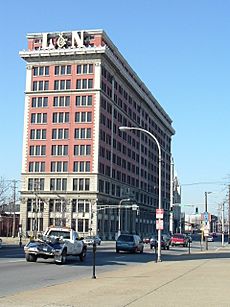
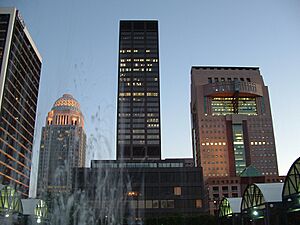
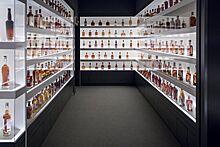
Louisville has many companies and organizations. The city's economy has always been strong in shipping and cargo. Its location is perfect for moving goods. It is within a day's drive of 60% of U.S. cities.
The Louisville and Portland Canal and the Louisville and Nashville Railroad were important for transportation. Today, Louisville is still a key shipping center. UPS has its huge global air-freight hub at Louisville Muhammad Ali International Airport.
Louisville is also at the crossing of three major interstate highways. These are I-64, I-65, and I-71. This makes it important for shipping goods by road. The Port of Louisville also continues river shipping. Louisville is the seventh-largest inland port in the United States.
Louisville is a big center for manufacturing. It has two large Ford Motor Company plants. GE Appliances also has its headquarters and a big factory here. The city is also a major part of the American whiskey industry. About one-third of all bourbon whiskey comes from Louisville. Many whiskey companies, like Brown-Forman, are based here.
Louisville is also becoming known for its tech skills. Programs like Code Louisville teach people how to develop software.
Omega Mirror Products, based in Louisville, made most of the mirror balls in the U.S. in the 1970s.
Many movies have been filmed in or near Louisville. These include The Insider and Secretariat.
Top Employers in Louisville
Here are the top employers in Louisville as of 2023:
| # | Employer | Number of employees |
|---|---|---|
| 1 | United Parcel Service | 26,328 |
| 2 | Norton Healthcare | 15,044 |
| 3 | Jefferson County Public Schools | 14,000 |
| 4 | UofL Health | 13,136 |
| 5 | Ford Motor Company | 13,020 |
| 6 | Baptist Health | 8,657 |
| 7 | Walmart | 8,550 |
| 8 | GE Appliances | 8,500 |
| 9 | Humana Inc. | 7,465 |
| 10 | University of Louisville | 7,114 |
Louisville's Fun: Arts and Culture
Yearly Events: Festivals and Celebrations
Louisville hosts many exciting events each year. The most famous is the Kentucky Derby. It happens every year on the first Saturday of May. Before the Derby, there's a two-week-long Kentucky Derby Festival. This festival starts with Thunder Over Louisville, one of the biggest fireworks shows in North America.
The Kentucky Derby Festival also has other fun events. These include the Pegasus Parade, the The Great Steamboat Race, and a Great Balloon Race. There's also a marathon and mini marathon. The festival has about seventy events in total.
During the summer, Louisville has the Kentucky Shakespeare Festival. This festival offers free Shakespeare plays. They are held in Central Park in Old Louisville from May to August.
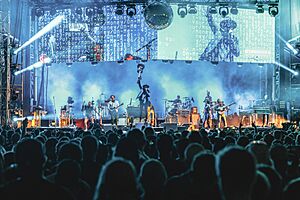
The Forecastle Festival used to draw many visitors to Louisville Waterfront Park. It celebrated music, art, and environmental action. It was replaced in 2024 by the Gazebo Festival. This new festival featured Louisville's own Jack Harlow.
The Kentucky State Fair is held every August in Louisville. It showcases culture from all over Kentucky. The African American community also celebrates Juneteenth. This day remembers when enslaved African Americans learned they were free.
The Jeffersontown neighborhood hosts the annual Jeffersontown Gaslight Festival. This week-long event attracts hundreds of thousands of people.
In October, the St. James Court Art Show takes place in Old Louisville. Thousands of artists show and sell their work. Many art collectors attend this event. It brings in over 150,000 people and millions of dollars in sales.
Another art event is the First Friday Hop. This happens every month.
Local Scene: Indie Culture
Bardstown Road is a popular area in the Highlands. It is known for its diverse culture and local shops. This street is a big part of Louisville's unique lifestyle. It helps support the unofficial "Keep Louisville Weird" slogan.
In downtown Louisville, the 21c Museum Hotel is special. It's a hotel that also shows modern art. It even has a red penguin on its roof.
Louisville has a lively indie music scene. Many bands and singer-songwriters come from here. These include My Morning Jacket and Jack Harlow.
WFPK Radio Louisville is a local public radio station. It plays music and supports Louisville's music scene.
Learning and Fun: Museums and Galleries
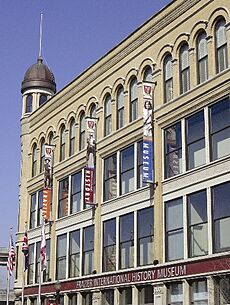
The West Main District in downtown Louisville is known as "Museum Row." Here you can find the Frazier History Museum. It opened in 2004 and focuses on history.
Also nearby is the Kentucky Science Center. This is Kentucky's largest hands-on science center. It has interactive exhibits and IMAX films. The Kentucky Museum of Art and Craft opened in 1981. The Muhammad Ali Center opened in 2005. It celebrates Louisville native Muhammad Ali and his boxing career.
The National Society of the Sons of the American Revolution (SAR) has a library here. It helps people research their family history.
The Speed Art Museum opened in 1927. It is the oldest and largest art museum in Kentucky. The museum has over 12,000 pieces of art. It also hosts traveling art shows. Many art galleries are in the city, especially in the East Market District (NuLu). These galleries are featured in the monthly First Friday Hop.
Several museums focus on local history. The Filson Historical Society, founded in 1884, has many old documents and artifacts. Other local history museums include the Portland Museum and Historic Locust Grove. The Falls of the Ohio State Park has a center that teaches about the area's natural history and fossils.
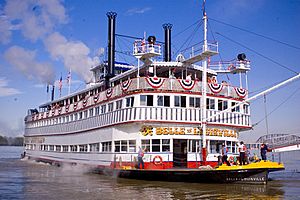
You can also visit historical places like the Belle of Louisville. It is the oldest Mississippi-style steamboat still running in the U.S. The United States Marine Hospital of Louisville is a very old hospital building. Fort Knox is home to the U.S. gold storage. Waverly Hills Sanatorium is an old hospital with many stories about it.
Live Shows: Performing Arts
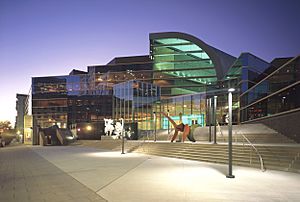
The Kentucky Center is a place for plays and concerts. It opened in 1983. It is home to the Louisville Ballet and the Louisville Orchestra. It also hosts Actors Theatre of Louisville and the Kentucky Opera.
Actors Theatre of Louisville puts on about 30 plays each year. From 1976 to 2021, it hosted the Humana Festival of New American Plays.
The Louisville Orchestra started in 1937. It performs over 125 concerts each year. In 2024, the orchestra won a Grammy Award.
The Palace Theatre is a beautiful old theater downtown. It shows movies and hosts concerts.
Iroquois Park has the Iroquois Amphitheater. This outdoor venue hosts many music concerts.
Louisville's Games: Sports Scene
College sports are very popular in Louisville. The Louisville Cardinals play in the Atlantic Coast Conference (ACC).
College basketball is especially big here. The Louisville Cardinals often sell out their games. They have won three national championships. The Cardinals also hold attendance records for women's basketball. Louisville has been ranked first in ratings for the NCAA men's basketball tournament since 1999.
The Louisville Cardinals football team has produced many successful NFL players. These include Lamar Jackson and Johnny Unitas. In 2016, Lamar Jackson won the Heisman Trophy. This award goes to the best college football player in the nation. The University of Louisville baseball team has also reached the College World Series multiple times.
Horse racing is a major attraction. Churchill Downs is home to the Kentucky Derby. This is the biggest sporting event in the state. It also hosts the Kentucky Oaks. Churchill Downs has also hosted the famous Breeders' Cup eight times.
Louisville is home to Valhalla Golf Club. This club has hosted the PGA Championship several times. It also hosted the Ryder Cup in 2008. The city has the David Armstrong Extreme Park. Skateboarder Tony Hawk has called it one of his top five skate parks.
Louisville has several professional and semi-professional sports teams. The Louisville Bats are a baseball team. They play in the International League and are linked to the Cincinnati Reds. Their home is Louisville Slugger Field downtown.
Louisville City FC is a professional soccer team. They started playing in 2015. They now play in their own stadium, Lynn Family Stadium. Racing Louisville FC is a women's soccer team. They started playing in 2021 at Lynn Family Stadium.
Louisville is the only city in the world that is the birthplace of four heavyweight boxing champions. These include Muhammad Ali.
Louisville's Professional Sports Teams
| Club | Sport | Began Play | League | Venue |
|---|---|---|---|---|
| Louisville Bats | Baseball | 2002 | International League | Louisville Slugger Field |
| Derby City Dynamite | Women's football | 2013 | Women's Football Alliance | John Hardin High School (Radcliff) |
| Louisville City FC | Men's soccer | 2015 | United Soccer League | Lynn Family Stadium |
| Racing Louisville FC | Women's soccer | 2021 | National Women's Soccer League | Lynn Family Stadium |
Outdoor Fun: Parks and Recreation
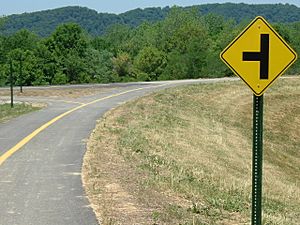
Louisville Metro has 122 city parks. They cover over 13,000 acres (5,300 hectares). Many of these parks were designed by Frederick Law Olmsted. He also designed New York City's Central Park.
Louisville Waterfront Park is on the banks of the Ohio River downtown. It has large open areas for free concerts and festivals. The Big Four Bridge is a former railroad bridge. It is now a pedestrian bridge connecting Waterfront Park to Jeffersonville, Indiana.
Cherokee Park is one of the most visited parks in the nation. It has a 2.6-mile (4.2 km) loop for walking and biking. Other notable parks include Iroquois Park, Shawnee Park, and Seneca Park.
Further from downtown is the Jefferson Memorial Forest. At 6,676 acres (2,702 hectares), it is one of the largest city urban forests in the U.S. It has nearly 60 miles (97 km) of hiking and horse trails.
Otter Creek Outdoor Recreation Area is another large park nearby. It has a scenic view of the Ohio River.
Other outdoor places to visit include Cave Hill Cemetery (where Col. Harland Sanders is buried). There's also the Louisville Zoo and the Falls of the Ohio National Wildlife Conservation Area.
A project called the City of Parks is creating a 110-mile (180 km) paved trail. It is called the Louisville Loop. This project also adds more park land.
Learning in Louisville: Education
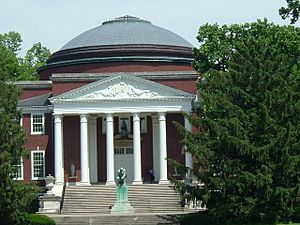
Louisville has many places for higher learning. There are six four-year universities. These include the University of Louisville, Bellarmine University, and Spalding University. There is also a two-year community college, Jefferson Community and Technical College.
The University of Louisville has made important medical advances. These include hand transplants and the first self-contained artificial heart transplant.
Two major religious schools are also in Louisville. The Southern Baptist Theological Seminary is a large institution. The Louisville Presbyterian Theological Seminary is also here.
About 21.3% of Louisville's population over 25 has a college degree or higher. About 76.1% have a high school diploma.
The public school system is Jefferson County Public Schools. It has over 100,000 students in 173 schools. Dupont Manual High School is ranked among the best high schools in the nation. Louisville also has 27 Catholic schools. The Kentucky School for the Blind is located in the city.
News and Entertainment: Media
Louisville's main newspaper is The Courier Journal. Another paper is the Louisville Eccentric Observer (LEO).
WAVE 3 is Kentucky's first TV station. WHAS 11 is another well-known TV station. It hosts the yearly WHAS Crusade for Children fundraiser. Other TV stations include WLKY 32 and WDRB 41.
The most popular radio stations are WGZB-FM and 84 WHAS 840 AM. WHAS 840 AM is a talk radio station. It also broadcasts regional sports.
Getting Around: Transportation
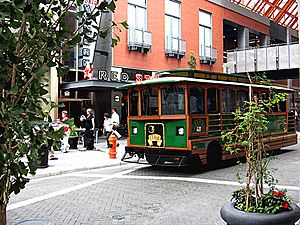
Louisville has inner and outer interstate highways. These are I-264 and I-265. Interstates I-64 and I-65 also pass through Louisville. I-71 ends in Louisville. These highways meet at a spot downtown called "Spaghetti Junction."
Three bridges carry I-64 and I-65 over the Ohio River. A fourth bridge carries other traffic, bikes, and pedestrians. The Big Four Bridge is a former railroad bridge. It is now a pedestrian bridge.
The Ohio River Bridges Project built two new interstate bridges over the Ohio River. One bridge, the Abraham Lincoln Bridge, is downtown. The other, the Lewis and Clark Bridge, connects I-265. Both bridges were finished in 2016.
Louisville's main airport is the Louisville Muhammad Ali International Airport. It is home to UPS's Worldport global air hub. This is UPS's largest package-handling hub. Over 4.2 million passengers use the airport each year. It is also one of the busiest airports in the world for cargo.
The McAlpine Locks and Dam is on the Ohio River. It helps ships pass the Falls of the Ohio.
Public transportation uses buses run by the Transit Authority of River City (TARC). These buses serve Louisville and nearby areas. Downtown, there are also zero-emissions buses called LouLift.
Louisville has always been a major center for railway traffic. Today, two major freight railroads serve the city. Louisville is the fifth largest city in the country without passenger train service.
In 2016, Louisville was ranked 43rd "most walkable" among U.S. cities.
City Services: Utilities
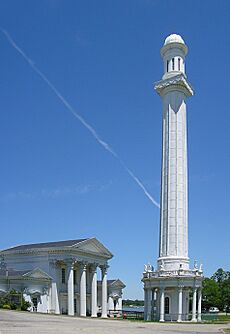
Electricity in Louisville is provided by Louisville Gas & Electric. Water is provided by the Louisville Water Company. It serves over 800,000 residents.
The Ohio River is the main source of drinking water. Water is taken from the river at two points. There are also two water treatment plants. In 2008, the Louisville Water Company won an award for the best-tasting drinking water in the country.
Famous People from Louisville
Louisville's Firsts: Important Achievements
Louisville has been home to many "firsts."
- The city hosted the second-largest American exhibition ever in 1883. It had the biggest display of light bulbs by their inventor, Thomas Edison.
- The first free public library in the U.S. for African Americans opened here in 1905.
- Medical advances include the first human hand transplant in the U.S. in 1999.
- The world's first self-contained artificial heart transplant happened here in 2001.
Louisville's Friends: Sister Cities
Louisville has several sister cities around the world:
 Adapazarı, Turkey
Adapazarı, Turkey Jiujiang, China
Jiujiang, China Mainz, Germany
Mainz, Germany Montpellier, France
Montpellier, France La Plata, Argentina
La Plata, Argentina Quito, Ecuador
Quito, Ecuador Tamale, Ghana
Tamale, Ghana
Louisville used to be a sister city with Perm, Russia. However, this relationship was paused in 2022. This was due to the Russian invasion of Ukraine.
Louisville also has friendly ties with Chengdu, China. They have cultural exchange programs and business projects.
Images for kids
-
Panorama from Jeffersonville, Indiana, with George Rogers Clark Memorial Bridge in foreground
See also
 In Spanish: Louisville para niños
In Spanish: Louisville para niños


